Effect of the Ca2Mg6Zn3 Phase on the Corrosion Behavior of Biodegradable Mg-4.0Zn-0.2Mn-xCa Alloys in Hank’s Solution
Abstract
:1. Introduction
2. Materials and Methods
2.1. Material Fabrication
2.2. Microstructural Characterization
2.3. Local Volta Potential Measurement
2.4. In Vitro Immersion Test
2.5. Electrochemical Measurement
3. Results
3.1. Microstructure of ZM-xCa Alloys
3.2. Electrochemical Properties of the ZM-xCa Alloys
3.3. Corrosion Behaviors of ZM-xCa Alloys
4. Discussion
5. Conclusions
- The cast ZM-xCa (0.1, 0.3, 0.5 and 1.0 wt.%) alloys contain the intragranular spherical Ca2Mg6Zn3 phase and the dendritic one at grain boundaries. The volume fraction of the Ca2Mg6Zn3 phase gradually increased from 2.5% to 7.6%, while its spacing declined monotonically from 43.0 μm to 30.0 μm with an increase in the added Ca amount from 0.1 wt.% to 1.0 wt.%.
- The Volta potential of the spherical Ca2Mg6Zn3 phase (+109 mV) was higher than that of the dendritic phase (+80 mV); hence, the spherical phase was electrochemically preferred as a cathode to accelerate Mg matrix (anode) dissolution in the micro-galvanic couple.
- The corrosion rate obtained by weight loss increased slightly with increasing Ca content from 0.1 wt.% to 0.5 wt.% because of the enhanced micro-galvanic corrosion effect. The decrease in the phase spacing and sharp increase in the secondary phase content resulted in a dramatic increase in the corrosion rate of the ZM-1.0Ca alloy.
Author Contributions
Funding
Institutional Review Board Statement
Informed Consent Statement
Data Availability Statement
Conflicts of Interest
References
- Birbilis, N.; Easton, M.A.; Sudholz, A.D.; Zhu, S.M.; Gibson, M.A. On the corrosion of binary magnesium-rate earth alloys. Corros. Sci. 2009, 51, 683–689. [Google Scholar] [CrossRef]
- Zhang, S.X.; Zhang, X.N.; Zhao, C.L.; Li, J.N.; Song, Y.; Xie, C.Y.; Tao, H.R.; Zhang, Y.; He, Y.H.; Jiang, Y.; et al. Research on an Mg–Zn alloy as a degradable biomaterial. Acta Biomater. 2010, 6, 626–640. [Google Scholar] [CrossRef]
- Du, W.B.; Liu, K.; Ma, K.; Wang, Z.H.; Li, S.B. Effects of trace Ca/Sn addition on corrosion behaviors of biodegradable Mg–4Zn–0.2Mn alloy. J. Magnes. Alloy 2018, 6, 1–14. [Google Scholar] [CrossRef]
- Munir, K.; Lin, J.X.; Wen, C.E.; Wright, P.F.A.; Li, Y.C. Mechanical, corrosion, and biocompatibility properties of Mg-Zr-Sr-Sc alloys for biodegradable implant applications. Acta Biomater. 2020, 102, 493–507. [Google Scholar] [CrossRef]
- Witte, F. The history of biodegradable magnesium implants. Acta Biomater. 2010, 6, 1680–1692. [Google Scholar] [CrossRef]
- Lu, Y.; Bradshaw, A.R.; Chiu, Y.L.; Jones, I.P. Effects of secondary phase and grain size on the corrosion of biodegradable Mg-Zn-Ca alloys. Mater. Sci. Eng. C 2015, 48, 480–486. [Google Scholar] [CrossRef]
- Witte, F.; Kaese, V.; Haferkamp, H.; Switzer, E.; Meyer-Lingenberg, A.; Wirth, C.J.; Windhagen, H. In vivo corrosion of four magnesium alloys and the associated bone response. Biomaterials 2005, 26, 3557–3563. [Google Scholar] [CrossRef] [PubMed]
- Zhao, M.C.; Liu, M.; Song, G.L.; Atrens, A. Influence of the β-phase morphology on the corrosion of the Mg alloy AZ91. Corros. Sci. 2008, 50, 1939–1953. [Google Scholar] [CrossRef]
- Atrens, A.; Song, G.L.; Liu, M.; Shi, Z.M.; Cao, F.Y.; Dargusch, M.S. Review of recent developments in the field of magnesium corrosion. Adv. Eng. Mater. 2015, 17, 400–453. [Google Scholar] [CrossRef]
- Cai, C.H.; Alvens, M.M.; Song, R.B.; Wang, Y.J.; Li, J.Y.; Montemor, M.F. Non-destructive corrosion study on a magnesium alloy with mechanical properties tailored for biodegradable cardiovascular stent applications. J. Mater. Sci. Technol. 2021, 66, 128–138. [Google Scholar] [CrossRef]
- Zengin, H.; Turen, Y. Effect of Y addition on microstructure and corrosion behavior of extruded Mg–Zn–Nd–Zr alloy. J. Magnes. Alloy 2020, 8, 640–653. [Google Scholar] [CrossRef]
- Jin, S.; Zhang, D.; Lu, X.P.; Zhang, Y.; Tan, L.L.; Liu, Y.; Wang, Q. Mechanical properties, biodegradability and cytocompatibility of biodegradable Mg-Zn-Zr-Nd/Y alloys. J. Mater. Sci. Technol. 2020, 47, 190–201. [Google Scholar] [CrossRef]
- Zhang, E.L.; Yang, L. Microstructure, mechanical properties and bio-corrosion properties of Mg-Zn-Mn-Ca alloy for biomedical application. Mater. Sci. Eng. A 2008, 497, 111–118. [Google Scholar] [CrossRef]
- Ding, Y.F.; Wen, C.E.; Hodgson, P.; Li, Y.C. Effects of alloying elements on the corrosion behavior and biocompatibility of biodegradable magnesium alloys: A review. J. Mater. Chem. B 2014, 2, 1912–1933. [Google Scholar] [CrossRef] [PubMed]
- Metalnikov, P.; Ben-Hamu, G.; Templeman, Y.; Shin, K.S.; Meshi, L. The relation between Mn additions, microstructure and corrosion behavior of new wrought Mg-5Al alloys. Mater. Charact. 2018, 145, 101–115. [Google Scholar] [CrossRef]
- Wang, J.F.; Huang, S.; Li, Y.; Wei, Y.Y.; Xi, X.F.; Cai, K.Y. Microstructure, mechanical and bio-corrosion properties of Mn-doped Mg–Zn–Ca bulk metallic glass composites. Mater. Sci. Eng. C 2013, 33, 3832–3838. [Google Scholar] [CrossRef]
- Cho, D.H.; Lee, B.W.; Park, J.Y.; Cho, K.M.; Park, I.M. Effect of Mn addition on corrosion properties of biodegradable Mg-4Zn-0.5Ca-xMn alloys. J. Alloys Compd. 2017, 695, 1166–1174. [Google Scholar] [CrossRef]
- Bazhenov, V.E.; Li, A.V.; Komissarov, A.A.; Koltygin, A.V.; Tavolzhanskii, S.A.; Bautin, V.A.; Voropaeva, O.O.; Mukhametshina, A.M.; Tokar, A.A. Microstructure and mechanical and corrosion properties of hot-extruded Mg-Zn-Ca-(Mn) biodegradable alloys. J. Magnes. Alloy 2020, 9, 1428–1442. [Google Scholar] [CrossRef]
- Cai, S.H.; Lei, T.; Li, N.F.; Feng, F.F. Effects of Zn on microstructure, mechanical properties and corrosion behavior of Mg-Zn alloys. Mater. Sci. Eng. C 2012, 32, 2570–2577. [Google Scholar] [CrossRef]
- Li, H.; Peng, Q.M.; Li, X.J.; Li, K.; Han, Z.S.; Fang, D.Q. Microstructures, mechanical and cytocompatibility of degradable Mg-Zn based orthopedic biomaterials. Mater. Des. 2014, 58, 43–51. [Google Scholar] [CrossRef]
- Zhang, E.L.; Yang, L.; Xu, J.W.; Chen, H.Y. Microstructure, mechanical properties and bio-corrosion properties of Mg-Si(-Ca, Zn) alloy for biomedical application. Acta Biomater. 2010, 6, 1756–1762. [Google Scholar] [CrossRef]
- Song, Y.W.; Han, E.H.; Shan, D.Y.; Yim, C.D.; You, B.Y. The effect of Zn concentration on the corrosion behavior of Mg-xZn alloys. Corros. Sci. 2012, 65, 322–330. [Google Scholar] [CrossRef]
- Zander, D.; Zumdick, N.A. Influence of Ca and Zn on the microstructure and corrosion of biodegradable Mg–Ca–Zn alloys. Corros. Sci. 2015, 93, 222–233. [Google Scholar] [CrossRef]
- Erdmann, N.; Angrisani, N.; Reifenrath, J.; Lucas, A.; Thorey, F.; Bormann, D.; Meyer-Lindenberg, A. Biomechanical testing and degradation analysis of MgCa0.8 alloy screws: A comparative in vivo study in rabbits. Acta Biomater. 2011, 7, 1421–1428. [Google Scholar] [CrossRef]
- Li, Z.J.; Gu, X.N.; Lou, S.Q.; Zheng, Y.F. The development of binary Mg-Ca alloys for use as biodegradable materials within bone. Biomaterials 2008, 29, 1329–1344. [Google Scholar] [CrossRef] [PubMed]
- Kim, W.C.; Kim, J.G.; Lee, J.Y.; Seok, H.K. Influence of Ca on the corrosion properties of magnesium for biomaterials. Mater. Lett. 2008, 62, 4146–4148. [Google Scholar] [CrossRef]
- Bakhsheshi-Rad, H.R.; Abdul-Kadir, M.R.; Idris, M.H.; Farahany, S. Relationship between the corrosion behavior and the thermal characteristics and microstructure of Mg-0.5Ca-xZn alloys. Corros. Sci. 2012, 64, 184–197. [Google Scholar] [CrossRef] [Green Version]
- Asadi, J.; Korojy, B.; Hosseini, A.; Alishahi, M. Effect of cell structure on mechanical and bio-corrosion behavior of biodegradable Mg-Zn-Ca foam. Mater. Today Commun. 2021, 28, 102715. [Google Scholar] [CrossRef]
- Gong, C.W.; He, X.Z.; Fang, D.Q.; Liu, B.S.; Yan, X. Effect of second phases on discharge properties and corrosion behaviors of the Mg-Ca-Zn anodes for primary Mg-air batteries. J. Alloys Compd. 2021, 861, 158493. [Google Scholar] [CrossRef]
- Meng, X.; Jiang, Z.T.; Zhu, S.J.; Guan, S.K. Effects of Sr addition on microstructure, mechanical and corrosion properties of biodegradable Mg–Zn–Ca alloy. J. Alloys Compd. 2020, 838, 155611. [Google Scholar] [CrossRef]
- Cheng, Y.F.; Du, W.B.; Liu, K.; Fu, J.J.; Wang, Z.H.; Li, S.B.; Fu, J.L. Mechanical properties and corrosion behaviors of Mg-4Zn-0.2Mn-0.2Ca alloy after long term in vitro degradation. Trans. Nonferrous Met. Soc. China 2020, 30, 363–372. [Google Scholar] [CrossRef]
- Liu, J.; Yang, L.X.; Zhang, C.Y.; Zhang, B.; Zhang, T.; Li, Y.; Wu, K.M.; Wang, F.H. Significantly improved corrosion resistance of Mg-15Gd-2Zn-0.39Zr alloys: Effect of heat-treatment. J. Mater. Sci. Technol. 2019, 35, 1644–1654. [Google Scholar] [CrossRef]
- Duley, P.; Sanyal, S.; Bandyopadhyay, T.K.; Mandal, S. Homogenization-induced age-hardening behavior and room temperature mechanical properties of Mg-4Zn-0.5Ca-0.16Mn (wt%) alloy. Mater. Des. 2019, 164, 107554. [Google Scholar] [CrossRef]
- Zhang, Y.; Li, J.X.; Li, J.Y. Effects of calcium addition on phase characteristics and corrosion behaviors of Mg-2Zn-0.2Mn-xCa in simulated body fluid. J. Alloys Compd. 2017, 728, 37–46. [Google Scholar] [CrossRef]
- Jiang, M.G.; Xu, C.; Nakata, T.; Yan, H.; Chen, R.S.; Kamado, S. Development of dilute Mg-Zn-Ca-Mn alloy with high performance via extrusion. J. Alloys Compd. 2016, 668, 13–21. [Google Scholar] [CrossRef]
- Liu, C.Q.; Chen, X.H.; Chen, J.; Atrens, A.; Pan, F.S. The effects of Ca and Mn on the microstructure, texture and mechanical properties of Mg-4Zn alloy. J. Magnes. Alloy. 2020, 9, 1084–1097. [Google Scholar] [CrossRef]
- Liu, J.H.; Song, Y.W.; Chen, J.C.; Chen, P.; Shan, D.Y.; Han, E.H. The Special Role of Anodic Second Phases in the Micro-galvanic Corrosion of EW75 Mg Alloy. Electrochim. Acta 2016, 189, 190–195. [Google Scholar] [CrossRef]
- Cai, C.H.; Song, R.B.; Wang, L.X.; Li, J.Y. Effect of anodic T phase on surface micro-galvanic corrosion of biodegradable Mg-Zn-Zr-Nd alloys. Appl. Surf. Sci. 2018, 462, 243–254. [Google Scholar] [CrossRef]
- Gui, Z.Z.; Kang, Z.X.; Li, Y.Y. Corrosion mechanism of the as-cast and as-extruded biodegradable Mg-3.0Gd-2.7Zn-0.4Zr-0.1Mn alloys. Mater. Sci. Eng. C 2019, 96, 831–840. [Google Scholar] [CrossRef]
- Zhang, T.; Meng, G.Z.; Shao, Y.W.; Cui, Z.Y.; Wang, F.H. Corrosion of hot extrusion AZ91 magnesium alloy. Part II: Effect of rare earth element neodymium (Nd) on the corrosion behavior of extruded alloy. Corros. Sci. 2011, 53, 2934–2942. [Google Scholar] [CrossRef]
- Bakhsheshi-Rad, H.R.; Idris, M.H.; Abdul-Kadir, M.R.; Ourdjini, A.; Medraj, M.; Daroonparvar, M.; Hamzah, E. Mechanical and bio-corrosion properties of quaternary Mg–Ca–Mn–Zn alloys compared with binary Mg–Ca alloys. Mater. Des. 2014, 53, 283–292. [Google Scholar] [CrossRef]
- Pan, H.; Pang, K.; Cui, F.Z.; Ge, F.; Man, C.; Wang, X.; Cui, Z.Y. Effect of alloyed Sr on the microstructure and corrosion behavior of biodegradable Mg-Zn-Mn alloy in Hanks’ solution. Corros. Sci. 2019, 157, 420–437. [Google Scholar] [CrossRef]
- Yin, S.Q.; Duan, W.C.; Liu, W.H.; Wu, L.; Yu, J.M.; Zhao, Z.L.; Liu, M.; Wang, P.; Cui, J.Z.; Zhang, Z.Q. Influence of specific second phases on corrosion behaviors of Mg-Zn-Gd-Zr alloys. Corros. Sci. 2020, 166, 108419. [Google Scholar] [CrossRef]
- Wei, L.Y.; Li, J.Y.; Zhang, Y.; Lai, H.Y. Effects of Zn content on microstructure, mechanical and degradation behaviors of Mg-xZn-0.2Ca-0.1Mn alloys. Mater. Chem. Phys. 2020, 241, 122441. [Google Scholar] [CrossRef]
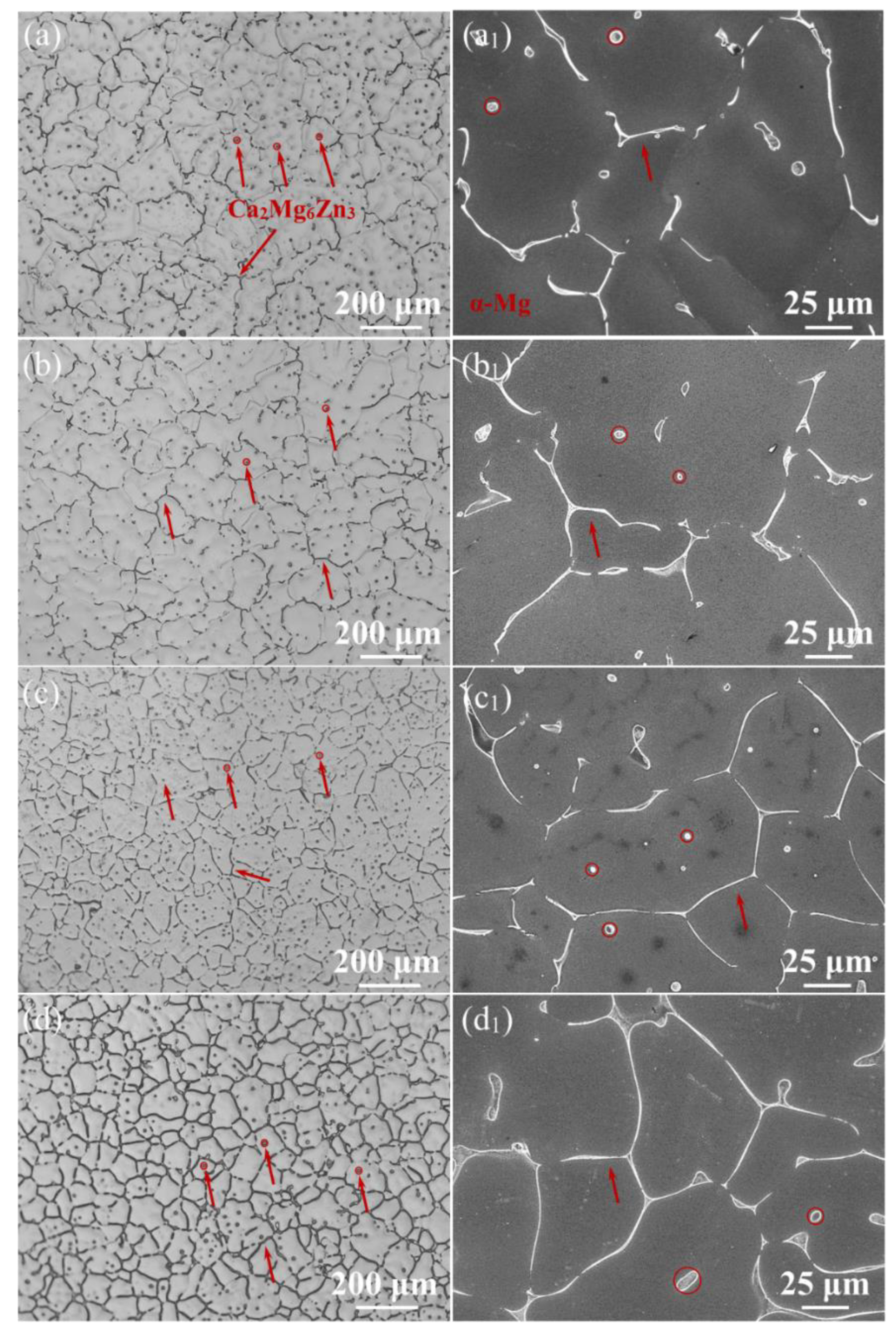

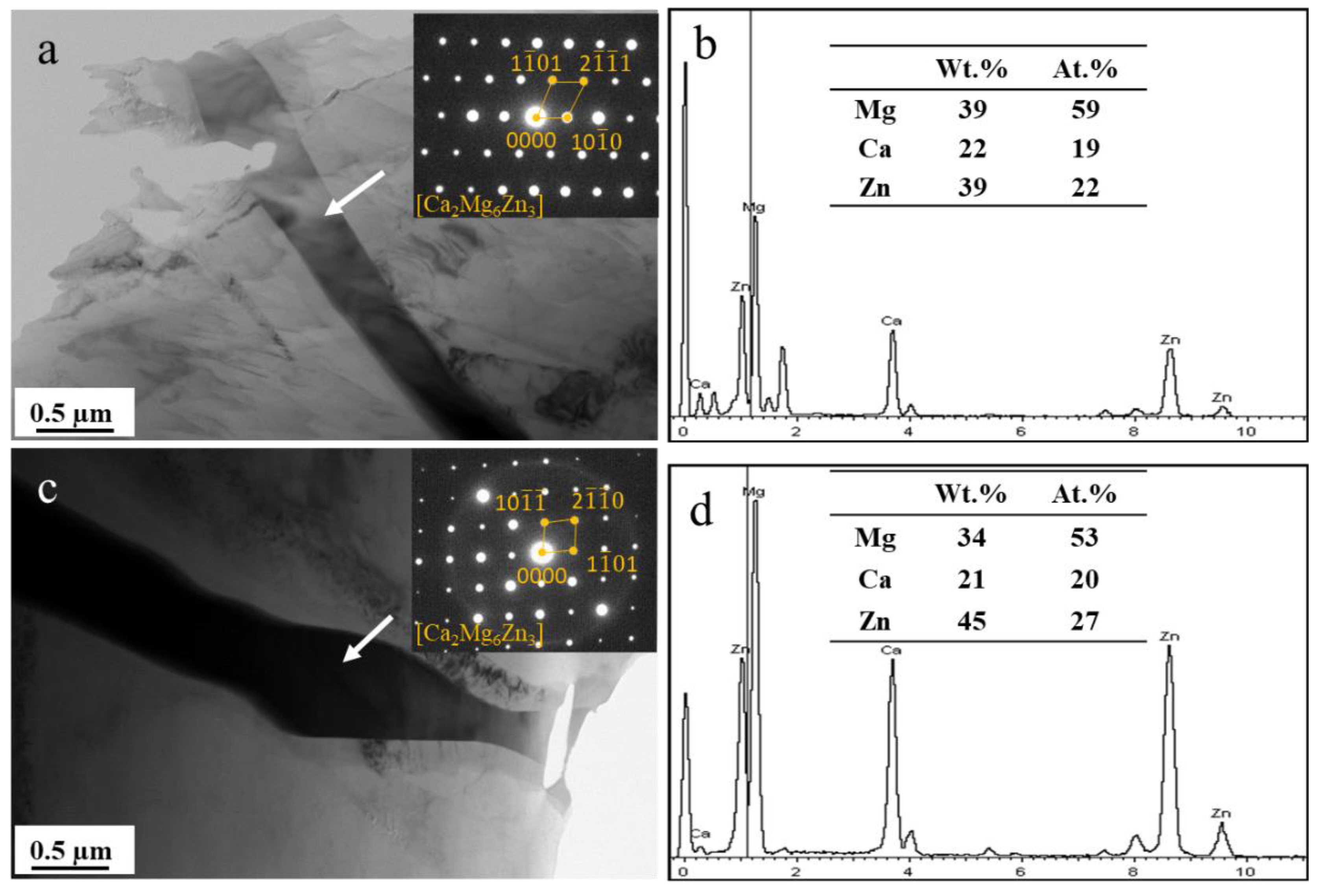
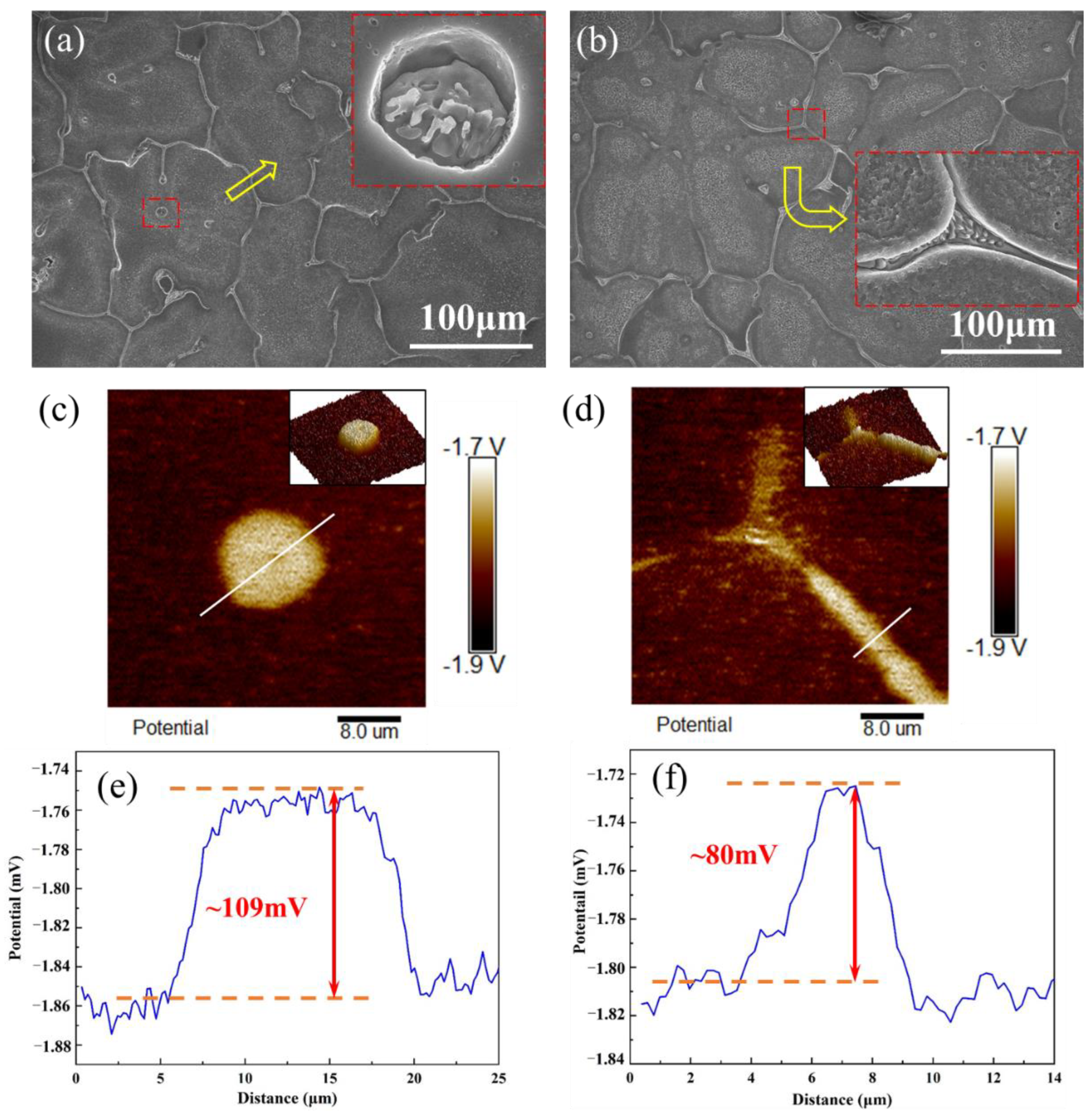
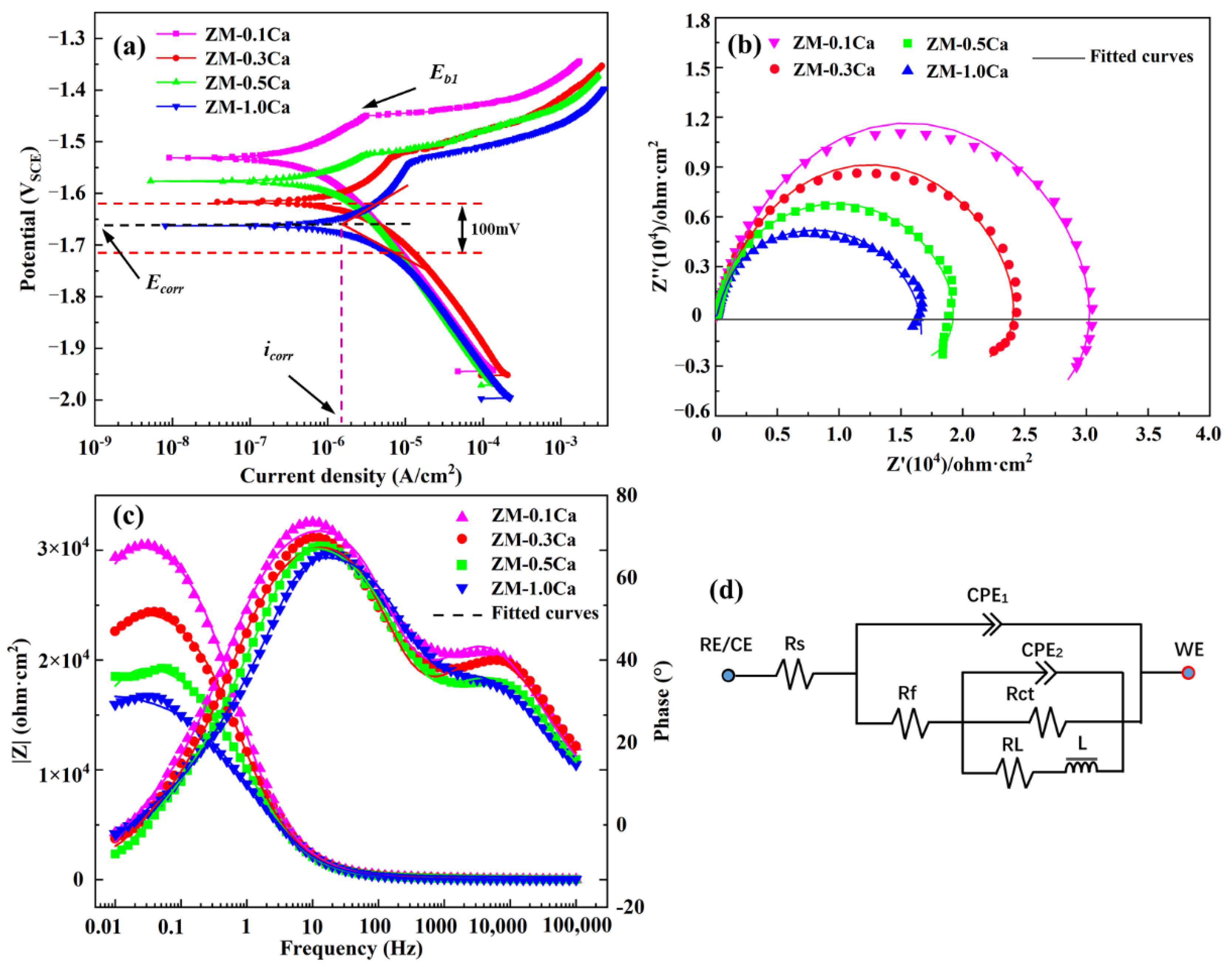
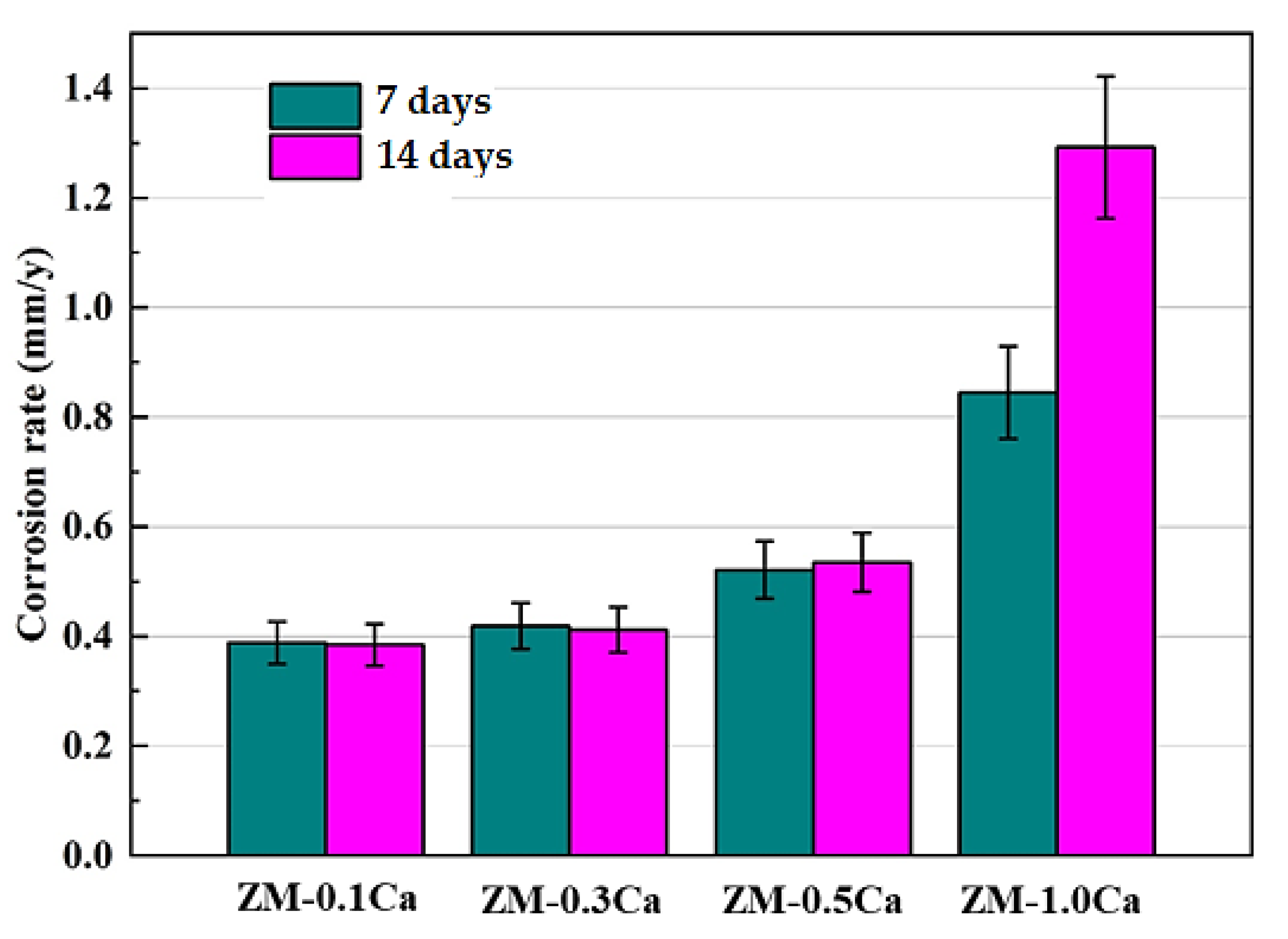


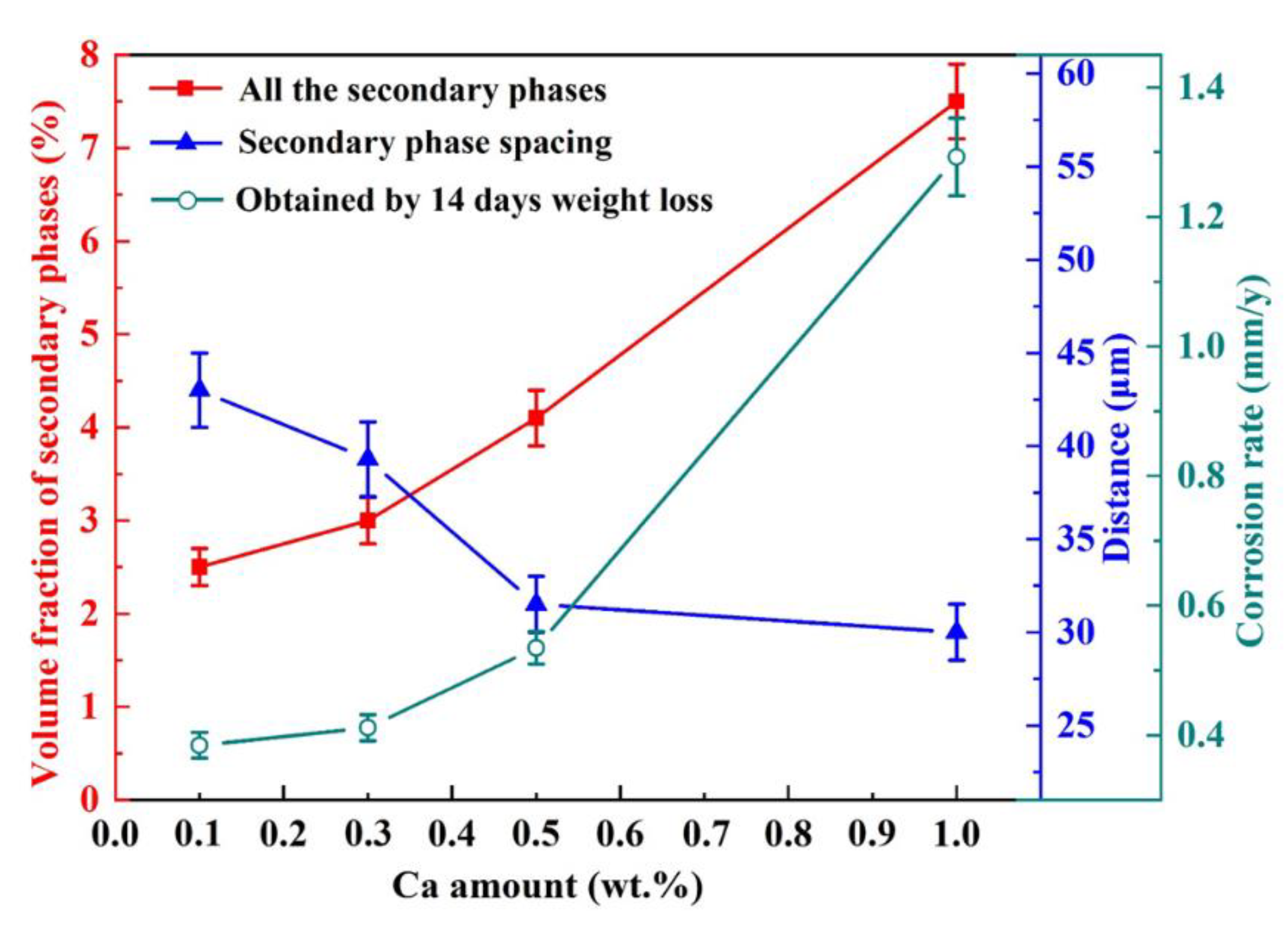
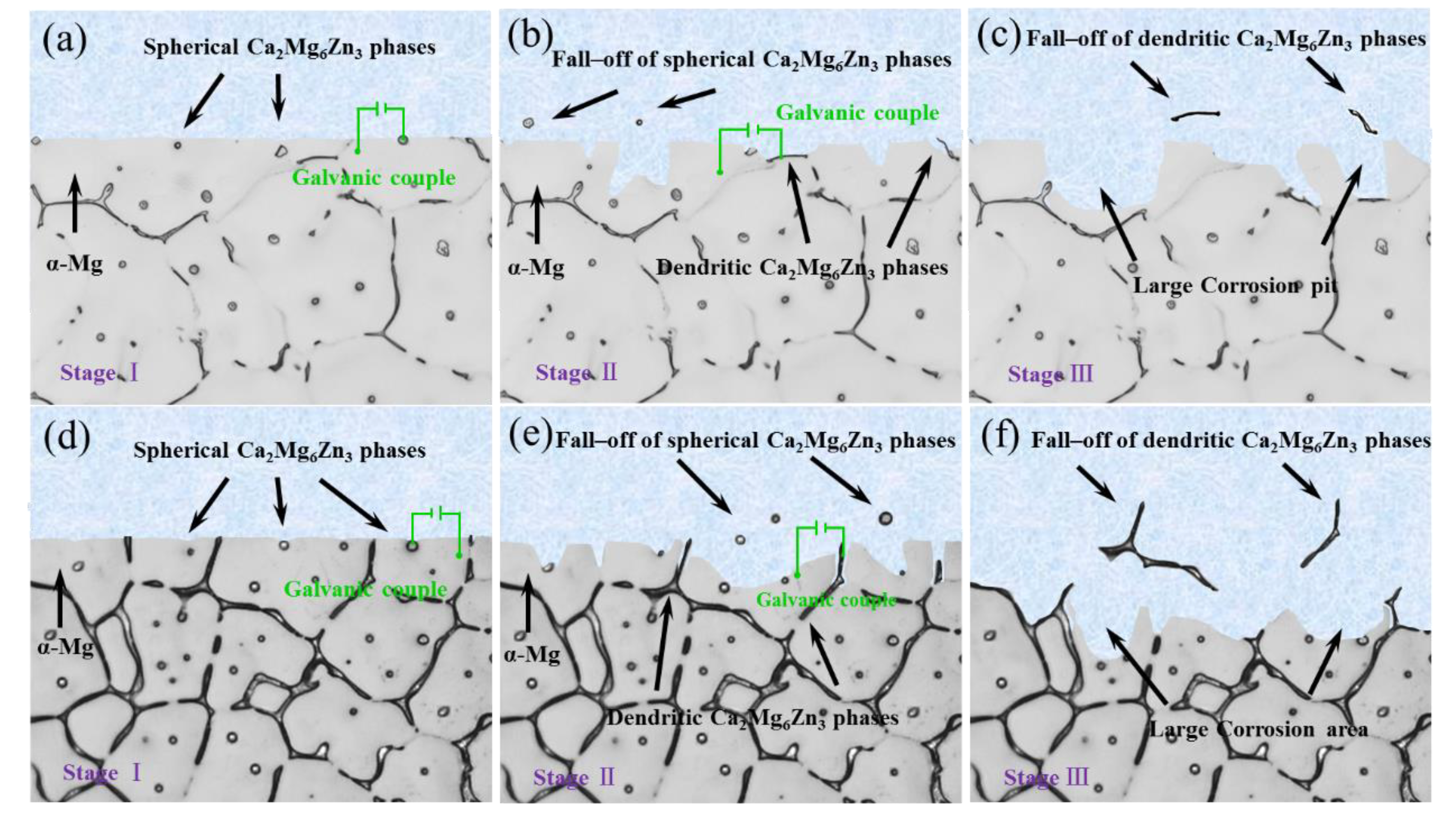
| Alloys | Actual Compositions (wt.%) | ||||
|---|---|---|---|---|---|
| Zn | Mn | Ca | Si | Mg | |
| ZM-0.1Ca | 4.13 | 0.20 | 0.12 | <0.02 | Bal. |
| ZM-0.3Ca | 3.81 | 0.17 | 0.34 | <0.02 | Bal. |
| ZM-0.5Ca | 3.78 | 0.18 | 0.56 | <0.03 | Bal. |
| ZM-1.0Ca | 3.76 | 0.18 | 0.95 | <0.02 | Bal. |
| Alloys | Volume Fraction of Secondary Phase (%) | Secondary Phase Spacing (μm) |
|---|---|---|
| ZM-0.1Ca | 2.5 ± 0.2 | 43.4 ± 2.0 |
| ZM-0.3Ca | 3.0 ± 0.2 | 39.3 ± 2.1 |
| ZM-0.5Ca | 4.2 ± 0.3 | 32.5 ± 1.5 |
| ZM-1.0Ca | 7.6 ± 0.4 | 30.1 ± 1.2 |
| Alloys | Ecorr (V) | icorr (A/cm2) | Eb (V) |
|---|---|---|---|
| ZM-0.1Ca | −1.530 | 5.90 × 10−7 | −1.450 |
| ZM-0.3Ca | −1.575 | 6.63 × 10−7 | −1.524 |
| ZM-0.5Ca | −1.617 | 6.77 × 10−7 | −1.527 |
| ZM-1.0Ca | −1.662 | 1.31 × 10−6 | −1.542 |
| Alloys | Rs (Ω cm2) | Rf (Ω cm2) | CPE1 (10–6 F/cm2) | n1 | CPE2 (10–6 F/cm2) | n2 | Rct (kΩ cm2) | RL (kΩ cm2) | L (H cm2) | RP (kΩ cm2) |
|---|---|---|---|---|---|---|---|---|---|---|
| ZM-0.1Ca | 25.48 | 281.31 | 7.60 | 0.73 | 6.31 | 0.90 | 31.29 | 53.97 | 2.26 × 106 | 20.11 |
| ZM-0.3Ca | 22.41 | 278.43 | 9.13 | 0.70 | 6.66 | 0.89 | 25.17 | 70.05 | 1.61 × 106 | 18.80 |
| ZM-0.5Ca | 22.40 | 230.21 | 11.71 | 0.69 | 8.83 | 0.85 | 45.69 | 20.25 | 1.12 × 106 | 14.28 |
| ZM-1.0Ca | 21.57 | 206.30 | 19.08 | 0.66 | 5.16 | 0.88 | 10.80 | 16.90 | 2.30 × 106 | 6.86 |
Publisher’s Note: MDPI stays neutral with regard to jurisdictional claims in published maps and institutional affiliations. |
© 2022 by the authors. Licensee MDPI, Basel, Switzerland. This article is an open access article distributed under the terms and conditions of the Creative Commons Attribution (CC BY) license (https://creativecommons.org/licenses/by/4.0/).
Share and Cite
Fu, J.; Du, W.; Liu, K.; Du, X.; Zhao, C.; Liang, H.; Mansoor, A.; Li, S.; Wang, Z. Effect of the Ca2Mg6Zn3 Phase on the Corrosion Behavior of Biodegradable Mg-4.0Zn-0.2Mn-xCa Alloys in Hank’s Solution. Materials 2022, 15, 2079. https://doi.org/10.3390/ma15062079
Fu J, Du W, Liu K, Du X, Zhao C, Liang H, Mansoor A, Li S, Wang Z. Effect of the Ca2Mg6Zn3 Phase on the Corrosion Behavior of Biodegradable Mg-4.0Zn-0.2Mn-xCa Alloys in Hank’s Solution. Materials. 2022; 15(6):2079. https://doi.org/10.3390/ma15062079
Chicago/Turabian StyleFu, Junjian, Wenbo Du, Ke Liu, Xian Du, Chenchen Zhao, Hongxing Liang, Adil Mansoor, Shubo Li, and Zhaohui Wang. 2022. "Effect of the Ca2Mg6Zn3 Phase on the Corrosion Behavior of Biodegradable Mg-4.0Zn-0.2Mn-xCa Alloys in Hank’s Solution" Materials 15, no. 6: 2079. https://doi.org/10.3390/ma15062079
APA StyleFu, J., Du, W., Liu, K., Du, X., Zhao, C., Liang, H., Mansoor, A., Li, S., & Wang, Z. (2022). Effect of the Ca2Mg6Zn3 Phase on the Corrosion Behavior of Biodegradable Mg-4.0Zn-0.2Mn-xCa Alloys in Hank’s Solution. Materials, 15(6), 2079. https://doi.org/10.3390/ma15062079






